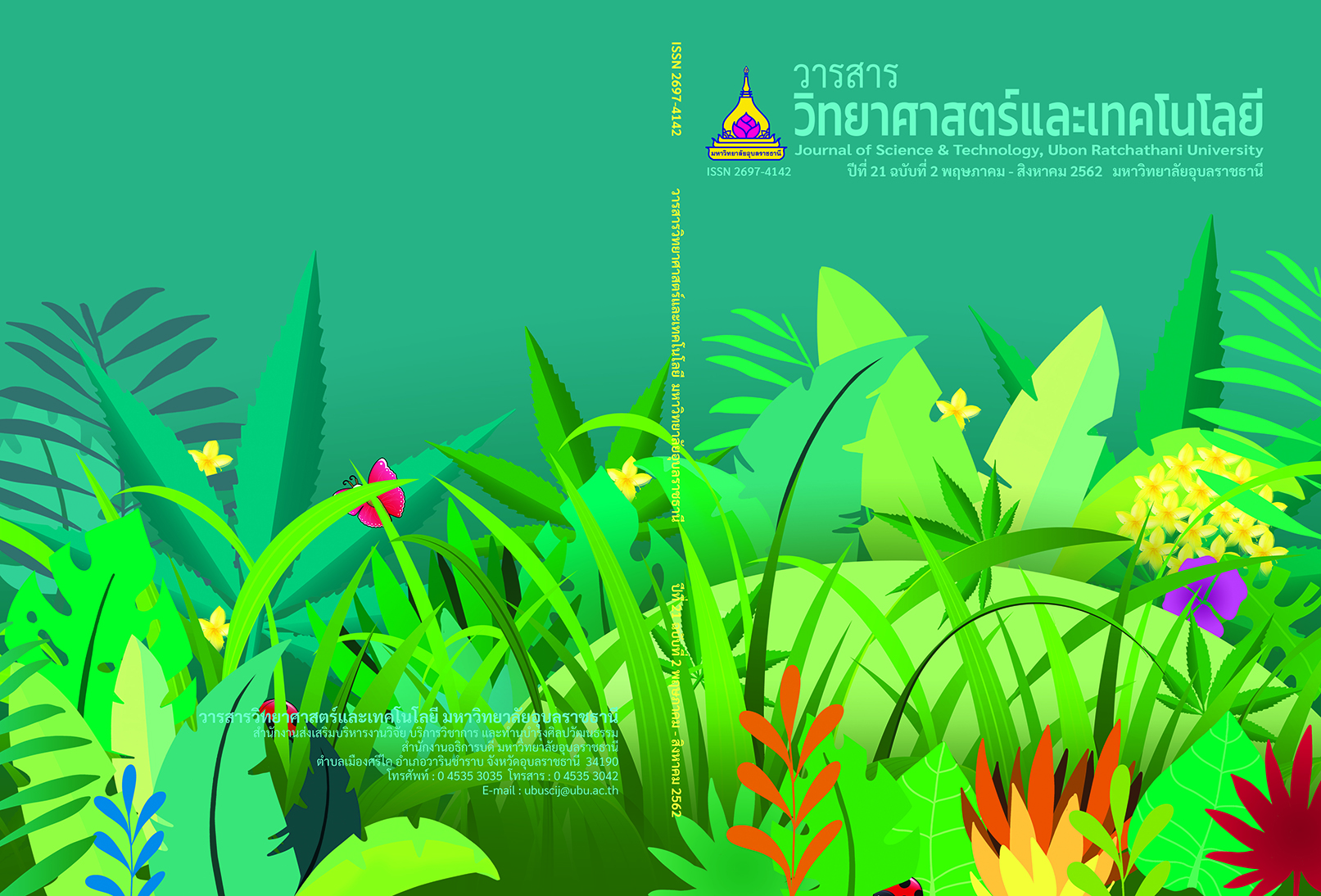อิทธิพลของสารสกัดดาวเรืองและการปลูกดาวเรืองแซมสลับถั่วเหลืองที่มีผลต่อประชากรเพลี้ยอ่อน ถั่วเหลืองและแมลงศัตรูธรรมชาติ
Main Article Content
บทคัดย่อ
การศึกษาประสิทธิภาพสารสกัดดาวเรืองในการเป็นสารฆ่าและสารไล่เพลี้ยอ่อนถั่วเหลืองอายุ 4 วัน ที่ระดับความเข้มข้น 0.3125, 0.625, 1.25, 2.5 และ 5% (w/v) วางแผนการทดลองแบบสุ่มสมบูรณ์ (completely randomized design; CRD) ความเข้มข้นละ 5 ซ้ำ ซ้ำละ 10 ตัว ทำการทดลองที่ห้องปฏิบัติการชีววิทยาที่อุณหภูมิ 25-27 องศาเซลเซียส ความชื้นสัมพัทธ์ 75-80 เปอร์เซ็นต์ ในแปลงทดลอง ทำการทดลองที่ จ.ปทุมธานี ศึกษาอิทธิพลของการปลูกดาวเรืองแซมสลับถั่วเหลืองที่มีต่อผลประชากรเพลี้ยอ่อนถั่วเหลืองแมลงศัตรูธรรมชาติความหลากหลายของแมลง วางแผนการทดลองแบบสุ่มบล็อกสมบูรณ์ (completely randomized block design; CRBD) แปลงทดลองทั้งหมด 12 แปลง ขนาด 7 x 5 เมตร ภายในแปลงระยะห่างระหว่างต้นและแถว 70 x 50 เซนติเมตร ระยะห่างระหว่างแปลงทดลอง 1 เมตร โดยมี 4 ชุดการทดลองแต่ละชุดการทดลองทำ 3 ซ้ำ ปลูกถั่วเหลือง 1 แถว + ดาวเรือง 1 แถว, ปลูกถั่วเหลือง 2 แถว + ดาวเรือง 1 แถว, ปลูกถั่วเหลือง 3 แถว + ดาวเรือง 1 แถว และปลูกถั่วเหลืองอย่างเดียว เมื่อต้นถั่วเหลืองอายุประมาณ 15 วัน ทำการสุ่มและเก็บตัวอย่างเพลี้ยอ่อนถั่วเหลืองและแมลงศัตรูธรรมชาติในแต่ละแปลงทดลองทุกสัปดาห์เป็นเวลา 6 สัปดาห์ ผลการทดลองพบว่าสารสกัดจากใบสาบเสือมีผลต่อการฆ่าและการไล่ของเพลี้ยอ่อนถั่วเหลืองมีความแตกต่างกันอย่างมีนัยสำคัญที่ระดับความเชื่อมั่น 95% ที่ความเข้มข้น 5% ของสารสกัดดาวเรืองมีผลต่อการฆ่าเพลี้ยอ่อนถั่วเหลืองสูงสุด คิดเป็นเปอร์เซ็นต์การตาย 92.0% ค่าความเป็นพิษ (LC50) เท่ากับ 0.435% ในชั่วโมงที่ 48 และมีผลต่อการไล่เพลี้ยอ่อนถั่วเหลืองสูงสุดคิดเป็นเปอร์เซ็นต์การไล่ 100% เมื่อเปรียบเทียบกับชุดควบคุม ในแปลงทดลองพบว่าแปลงปลูกสลับระหว่างถั่วเหลืองระหว่างดาวเรือง (1:1) มีจำนวนเพลี้ยอ่อนถั่วเหลืองต่ำสุดมีความแตกต่างอย่างมีนัยสำคัญที่ระดับความเชื่อมั่น 95% เท่ากับ 30.33+1.24, 48.66+0.61, 68.33+1.69, 80.33+1.69, 116.66+1.24 และ 145.33+1.63 ตัว/ 5 ต้น มีจำนวนแมลงศัตรูธรรมชาติสูงสุด ได้แก่ มดดำ ด้วงเต่า แมลงปอและแมงมุม ค่าดัชนีความหลากหลายของแมลงแปลงปลูกสลับระหว่างถั่วเหลืองกับดาวเรืองเท่ากับ 1.85
Article Details
บทความที่ได้รับการตีพิมพ์เป็นลิขสิทธิ์ของ วารสารวิทยาศาสตร์และเทคโนโลยี มหาวิทยาลัยอุบลราชธานี
ข้อความที่ปรากฏในบทความแต่ละเรื่องในวารสารวิชาการเล่มนี้เป็นความคิดเห็นส่วนตัวของผู้เขียนแต่ละท่านไม่เกี่ยวข้องกับมหาวิทยาลัยอุบลราชธานี และคณาจารย์ท่านอื่นๆในมหาวิทยาลัยฯ แต่อย่างใด ความรับผิดชอบองค์ประกอบทั้งหมดของบทความแต่ละเรื่องเป็นของผู้เขียนแต่ละท่าน หากมีความผิดพลาดใดๆ ผู้เขียนแต่ละท่านจะรับผิดชอบบทความของตนเองแต่ผู้เดียว
References
[1] อภิพรรณ พุกภักดี. 2546. ถั่วเหลือง: พืชทองของไทย.
มหาวิทยาลัยเกษตรศาสตร์. กรุงเทพฯ. 264 น.
[2] Tilmon, K.J. and et al. 2011. Biology of the soybean aphid, Aphis glycines
(Hemiptera: Aphididae) in the United States. J. Integ. Pest Mngmt. 2(2):1-7.
[3] Relyea, R.A. 2005. The impact of insecticides and herbicides on the
biodiversity and productivity of aquatic communities. Ecological
Applications. 15(2): 618–627.
[4] Al-Zaidi, A.A. and et al. 2011. Negative effects of pesticides on the
environment and the farmars awareness in Saudi Arabia: a case study. J.
Anim Plant Sci. 21(3): 605-611.
[5] Silva, A.X. and et al. 2012. Insecticide resistance mechanisms in thegreen
peach aphid Myzus persicae (Hemiptera: Aphididae) I: atranscriptomic
survey. PLoS ONE. 7(6):1-14.
[6] Bass, C. and et al. 2015. The global status of insect resistance to
neonicotinoid insecticides. Pesticide Biochemistry and Physiology. 121:
78–87.
[7] Mousavi, S.R. and Eskandari, H. 2011. A general overview on
intercropping and its advantages in sustainable agriculture. J. Appl.
Environ. Biol. Sci. 1(11): 482-486.
[8] รัตนาภรณ์ พรหมศรัทธา, มัณฑนา มิลน์ และอารมณ์ แสงวนิชย์.
การศึกษาองค์ประกอบทางเคมีของดาวเรือง. 2543. การประชุมทางวิชาการ
ของมหาวิทยาลัยเกษตรศาสตร์ครั้งที่ 39.
มหาวิทยาลัยเกษตรศาสตร์: กรุงเทพฯ. หน้า 406-409.
[9] อินทวัฒน์ บุรีคำ. 2548. นิเวศวิทยาวิเคราะห์ทางกีฏวิทยา. กรุงเทพฯ:
มหาวิทยาลัยเกษตรศาสตร์. 180 น.
[10] Morallo-Rejesus, B. and Decena, A. 1982. The activity, isolation,
purification and identification of insecticidal principles from
Tagetes. Phillip. J. Crop Sci. 7: 31-36.
[11] Huron, E.N. and et al. 2016. Toxicity and acute macromolecular
abnormalities induced by some plant extracts against the Cowpea aphid;
Aphis carricivora Koch. J. Plant Prot. and Path., Mansoura Univ.
7(7): 445 -449.
[12] Zhou, B.G. and et al. 2016. Aphicidal Activity of Illicium verum Fruit
Extracts and Their Effects on the Acetylcholinesterase and Glutathione S-
transferases Activities in Myzus persicae (Hemiptera: Aphididae). J Insect
Science. 16(1): 1–7.
[13] Dancewicz, K. Gabrys, B and Przybylska, M. 2011. Effect of
garlic (Allium sativum L.) and tansy (Tanaceum vulgare L.)
extracts and potassic horticultural soap on the probing and
feeding behaviour of Myzus persicae (Sulzer1776). Aphids and
Other Hemipterous Insects. 17: 129-136.
[14] Jaba, B. and et al. 2010. Olfactory response of cowpea aphid, Aphis
craccivora Koch, to host odours and population of conspecifics. Journal
of Biopesticides. 3(1): 405 – 407.
[15] Ikeura, H. Kobayashi F. and Hayata, Y. 2012. Repellent Effect of Herb
Extracts on the Population of Wingless Green Peach Aphid, Myzus
persicae Sulzer (Hemiptera: Aphididae). Journal of Agricultural Science.
4(5): 139-144.
[16] Pahla, I. and et al. 2012. Evaluation of Allium sativum and Allium cepa
intercrops on the control of Brevicoryne brassicae (Homoptera: Aphididae)
in Brassica napus. Intl J Farm & Alli Sci. 3(10): 1069-1074.
[17] ยรรยง เฉลิมแสน. 2556. การใช้แนวทางนิเวศวิศวกรรมในการจัดการศัตรูข้าว
เพื่อการผลิตข้าวหอมนิลอินทรีย์บ้านทุ่งใหญ่ ต.นิคมพัฒนา อ.บางระกำ จ.
พิษณุโลก. วารสารการพัฒนาชุมชนและคุณภาพชีวิต. 1(2): 63-70.

